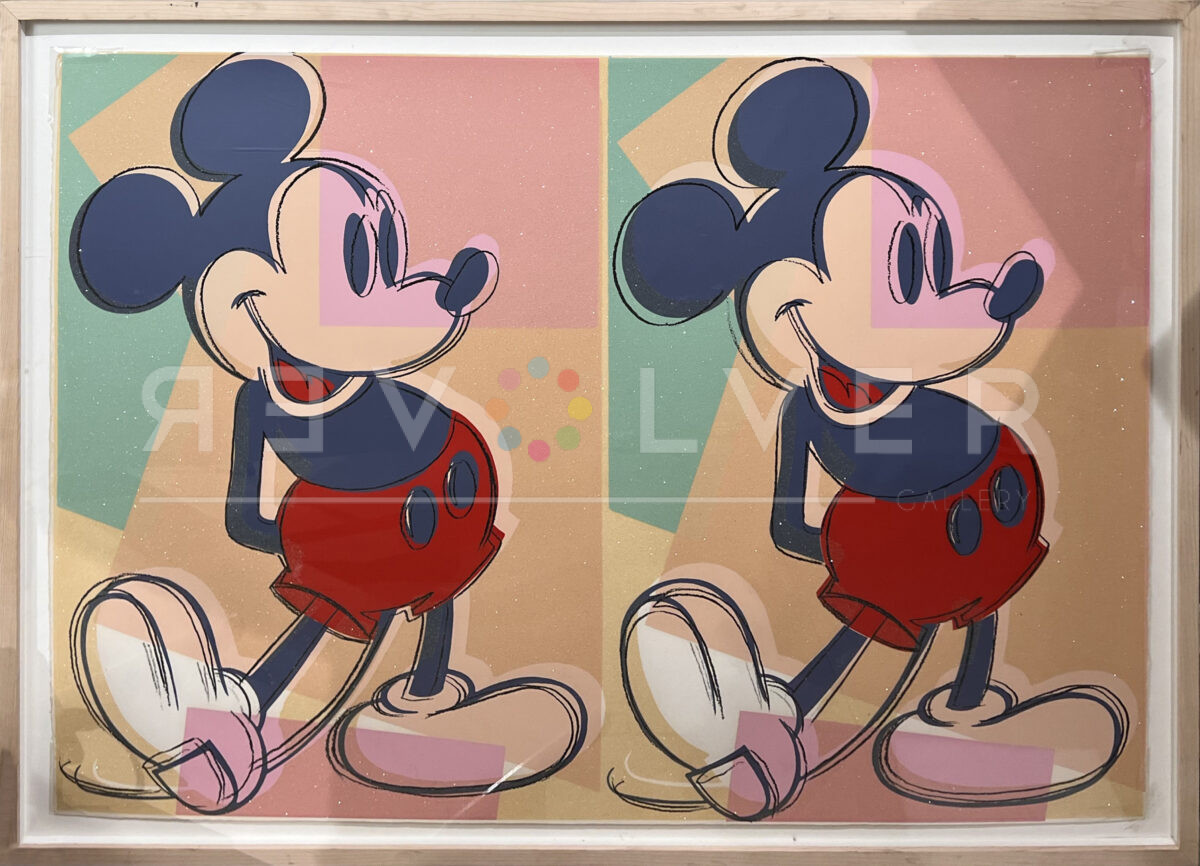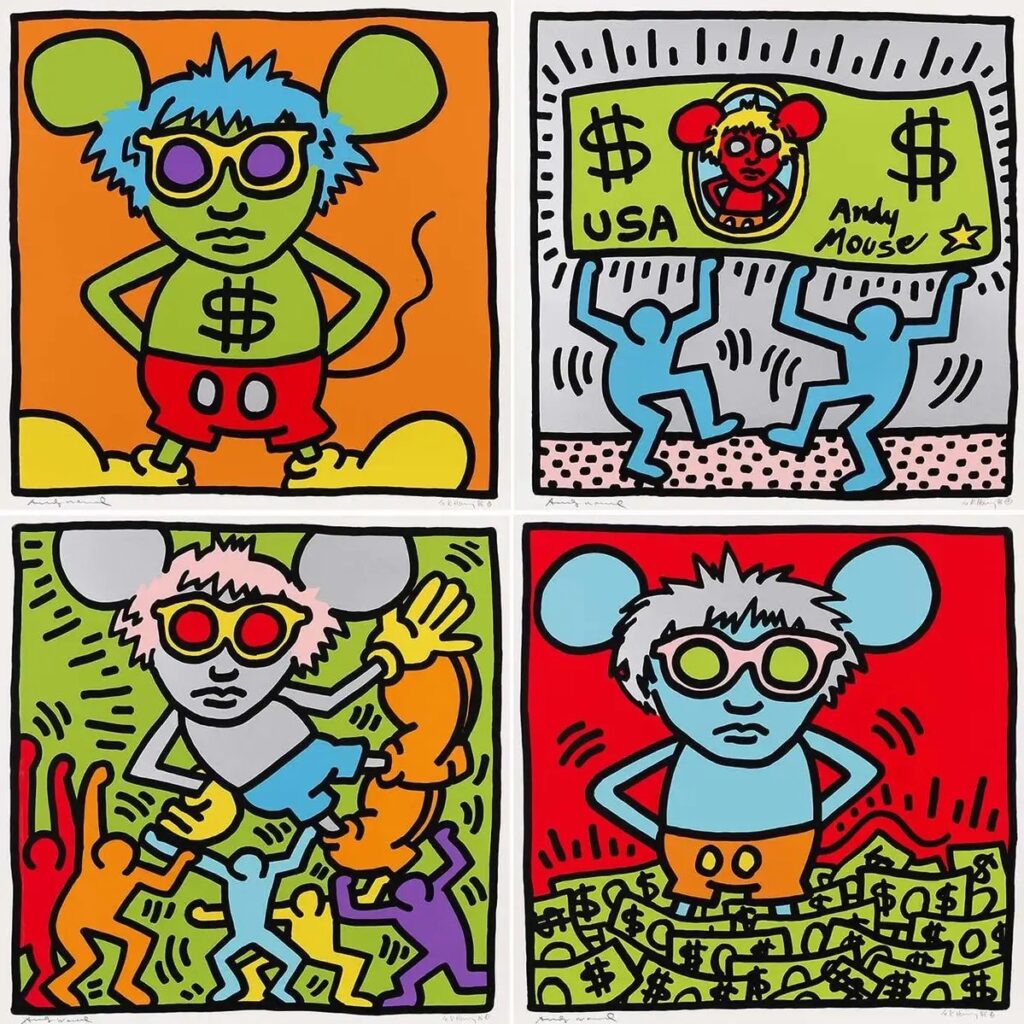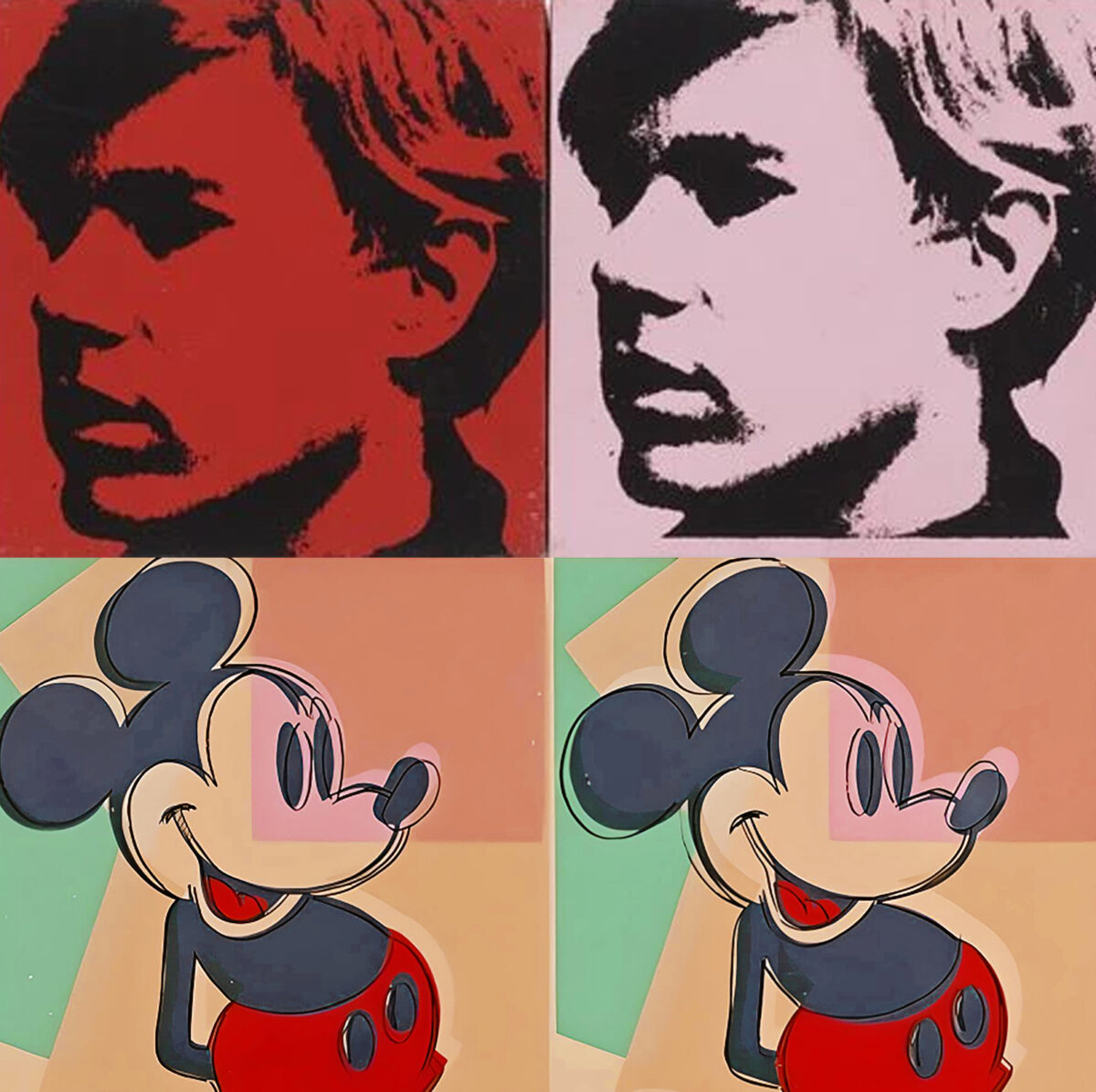
Revolver Gallery is excited to unveil its latest acquisition—Andy Warhol’s Double Mickey Mouse (FS II.269), a piece that commands attention not just for its visual appeal but also for its historical resonance. Created in 1981 as part of a limited edition of just 25 screenprints on Arches 88 paper, this work is a rare gem in Warhol’s extensive catalog.
But why Mickey Mouse? This iconic character isn’t just a staple of American pop culture; this plucky and adventurous mouse is a symbol that has captivated imaginations globally. The artwork is an extension of Warhol’s Myths series, a collection that explores the larger-than-life figures that populate America’s cultural narrative.
In this article, we’ll unpack the layers of meaning behind Warhol’s Double Mickey Mouse. We’ll explore its place within the Myths series, its significance in the context of Warhol’s lifelong fascination with American icons, and the broader impact of Mickey Mouse on the art world. So, if you’ve ever wondered why this cartoon mouse finds himself immortalized alongside Marilyn Monroe and Elvis Presley in Warhol’s art, read on.
Mickey Mouse: from Cultural Icon to American Myth
Mickey Mouse is more than a whimsical cartoon character; he’s a linchpin of American identity. Conceived by Walt Disney and Ub Iwerks in 1928, Mickey made his grand entrance in the animated short Steamboat Willie, quickly ascending from a mere doodle to a symbol of American ingenuity and optimism. His character, influenced by silent film legends like Charlie Chaplin and Douglas Fairbanks, embodies the quintessential underdog who triumphs against the odds. His petite frame and falsetto voice, originally lent by Walt Disney himself, contribute to his universal charm.
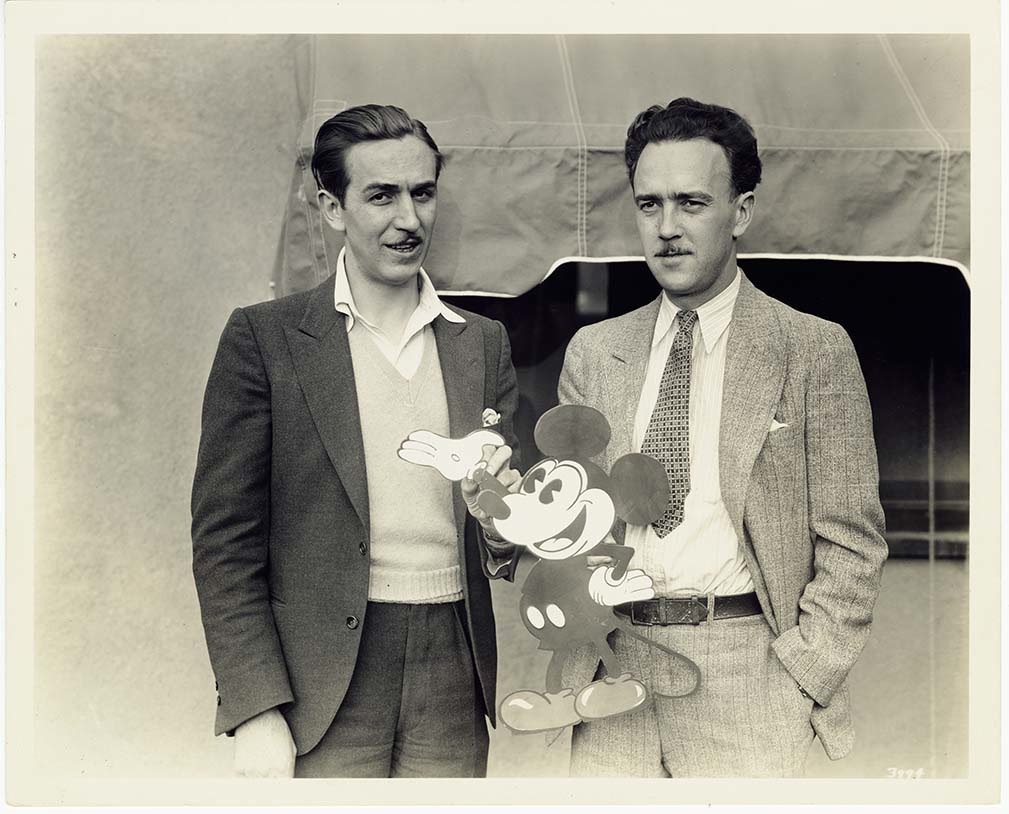
Mickey was designed to be an everyman—or rather, an everymouse. In his early days, Mickey was a bit of a rascal, a reflection of the rebellious zeitgeist of his time. However, as society and animation techniques evolved, so did Mickey’s character. His metamorphosis from the edgy protagonist in early black and white films to the more expressive, colorful character we see in Warhol’s artworks was largely the work of animator Fred Moore. Sporting his iconic red shorts, large yellow shoes, and white gloves, Mickey became a beacon of resilience and resourcefulness. This transformation aligned Mickey with Disney’s original vision, turning him into a moral guide for multiple generations and solidifying his status as the affable hero we recognize today.
But Mickey’s influence isn’t confined to the screen. With over 130 films and a 45-year comic strip legacy penned by Floyd Gottfredson, Mickey’s cultural footprint is unparalleled. It’s likely that a young Andrew Warhola Jr. encountered Mickey not only in animated films while growing up in Pittsburgh, but also through these widely syndicated comic strips, adding another dimension to his artistic fascination with the character.
Mickey Mouse transcends his role as a mere character; he’s etched into the American mythos, rubbing shoulders with cultural giants like Superman and Uncle Sam. These figures serve as avatars for American ideals, and Warhol, ever attuned to the media’s influence on public perception, saw Mickey as a potent symbol of America’s cultural prowess. Mickey’s rise from a humble steamboat operator to a global icon mirrors the American Dream, setting the stage for Warhol’s exploration of American myths and icons in his art.
Warhol's Mickey: a Mythical Interpretation
Although mainly populated by highly recognizable figures, Andy Warhol’s Myths series is a deeply introspective collection that mirrors facets of the artist’s own life, from his fascination with celebrity to his nuanced view of American culture. Within this series, Mickey Mouse emerges as a compelling figure, encapsulating Warhol’s respect for American creativity and his critique of consumerism.
Warhol’s Mickey Mouse is a refined rendition, based on Fred Moore’s 1936 redesign. Captured in three-quarter profile, Mickey’s iconic ears dominate the frame, while his vibrant red tongue and open-mouthed smile offer a stark contrast to the subdued background. Warhol’s signature flourishes—pink and gold hand-drawn outlines and a dash of diamond dust—elevate the piece, imbuing it with a sense of nostalgia that transports viewers back to their childhood.Warhol’s Mickey Mouse is a refined rendition, based on Fred Moore’s 1936 redesign. Captured in three-quarter profile, Mickey’s iconic ears dominate the frame, while his vibrant red tongue and open-mouthed smile offer a stark contrast to the subdued background. Warhol’s signature flourishes—pink and gold hand-drawn outlines and a dash of diamond dust—elevate the piece, imbuing it with a sense of nostalgia that transports viewers back to their childhood.
But Warhol’s Myths series is not just a gallery of famous faces; it’s a commentary on the commercialization of American folklore and media. These characters, though fictional, have become pillars of American entertainment, illustrating the power of media to transform anyone—even an animated mouse—into a cultural icon. Warhol’s Mickey is not just a tribute to a beloved character; it’s a mirror reflecting the artist’s own aspirations for media omnipresence, influenced by figures like Walt Disney who seamlessly blended creativity with commerce.
Warhol's Evolving Mickey: Double and Quadrant Masterpieces
Building on this, Warhol’s Double Mickey Mouse elevates his exploration of iconic imagery. This 1981 creation, limited to just 25 screenprints, is not only a rare find but also ranks among Warhol’s most valuable pieces. The print showcases Warhol’s enduring affinity for the repetition of imagery, evident in works ranging from his iconic Double Elvis paintings in the early sixties to his explorations of male torsos in the seventies. Delving into the aesthetics of stop-motion animation, Double Mickey Mouse captures a full body image of the character in subtle hues of pale yellow, pink, and ochre. The background, adorned with the signature “diamond dust” technique, conjures the enchantment of a starry night.
As an offshoot of Warhol’s broader portfolio that includes other cultural icons like Santa Claus and Howdy Doody, it offers a glimpse into America’s multifaceted cultural history. Double Mickey Mouse is more than a visually striking piece; it’s a window into Warhol’s intricate personality and his nuanced take on American culture. Its rarity and its high value—ranking among Warhol’s top 10 most valuable prints—underscores its significance, both as an artwork and as a cultural artifact.
In 1986, Warhol revisited the iconic mouse in a piece called Quadrant Mickey Mouse, a vibrant tableau that echoes the composition he used for his Four Marilyns in 1962. Here, Mickey is splashed across the canvas in quadruplicate, each iteration awash in luminescent hues like light purple, yellow, and blue. Warhol’s use of Mickey in this piece encapsulates the same themes of timeless allure and childlike wonder that have always been associated with the character. It serves as another layer in Warhol’s ongoing dialogue with Mickey, a conversation that explores not just the character but the very nature of American pop culture and its enduring icons.
Mickey as Warhol's Mirror
If all of the artworks in the Myths series reveal an aspect of the artist, what does Mickey Mouse reveal about Andy Warhol? In a word: aspiration. Mickey is Warhol’s dream of universal recognition and influence crystallized. Just as Walt Disney transformed a whimsical rodent into a global phenomenon, Warhol yearned to elevate his art to a similar stratosphere of influence.
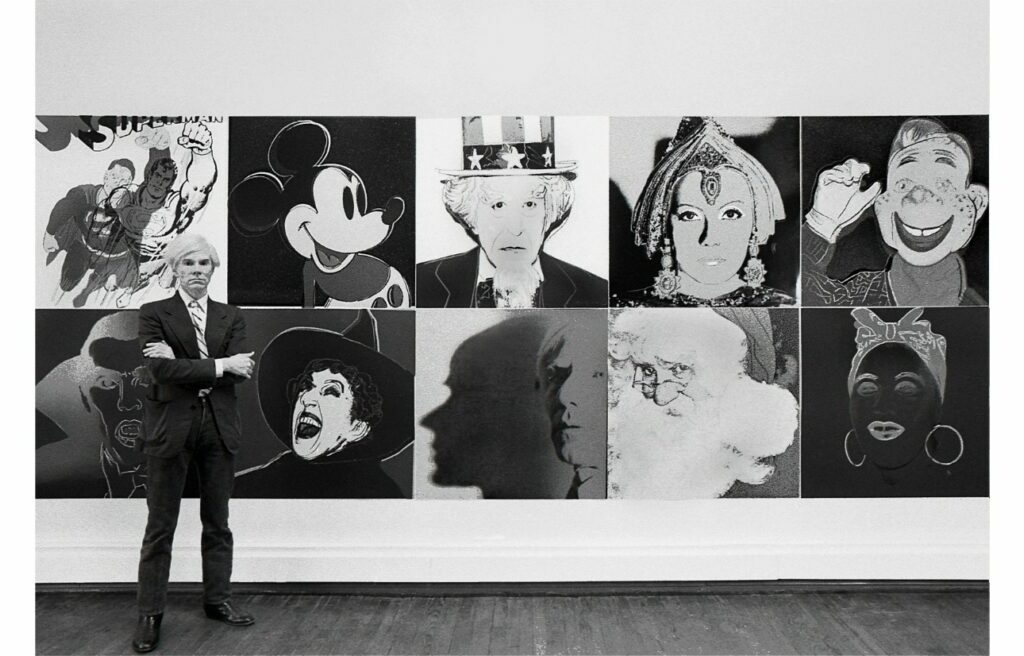
Warhol once said, “Everybody has their own America,” a patchwork quilt of personal experiences and cultural fantasies. His Myths series is precisely that—a tapestry of his “own America,” woven from the threads of early TV, film, and folklore. It’s not just a tribute to American entertainment idols; it’s Warhol’s personal time capsule, a nostalgic nod to the icons that colored both his childhood and the collective American psyche.
Mickey Mouse, as the iconic symbol of the Walt Disney company, holds a unique resonance for Warhol. He admired Disney not just as an artist but as a business savant who knew how to turn images into empires. Just as Disney’s animation studio churned out cultural landmarks, Warhol’s Factory aimed to be a crucible of artistic innovation and commercial success. In the same vein, Warhol’s Marilyns aren’t just depictions of a Hollywood star; they’re a brand, a signature, a Warhol.
So, why Mickey Mouse? Because Mickey is more than a character; he’s a state of mind. He embodies the carefree joy and innocence of childhood—a universal sentiment that transcends time and geography. In Mickey, Warhol found a mirror reflecting his own complexities: his aspirations, his cultural critiques, and his childlike wonder. Mickey Mouse isn’t just a subject in Warhol’s art; he’s a co-conspirator in Warhol’s exploration of the American Dream, both its glitter and its grit.
Mickey's Journey Beyond Warhol: Other Perspectives
Mickey Mouse’s artistic legacy transcends Warhol’s iconic interpretations. From postwar maestros to contemporary street artists, Mickey has been a muse, a canvas for creative expression that turns a mass-produced image into a singular work of art.
Before Warhol, artists like Mimmo Rotella and Roy Lichtenstein dabbled in the Disney magic. Rotella’s 1959 décollage, Topolino, named after Mickey’s Italian moniker, was a Cubist-inspired assemblage of torn posters. This work was a precursor to Pop Art, a genre Lichtenstein would soon revolutionize. His Look Mickey in 1961 marked a departure from abstract expressionism, employing Ben-Day dots and primary colors to give Mickey and Donald Duck a ‘pop’ makeover. Both artists set the stage for Warhol, using Mickey to critique and celebrate American culture.
Fast forward to the 21st century, and Mickey still captivates artists like Banksy, Damien Hirst, Mr. Brainwash, and Kaws. Banksy’s Mickey (titled Napalm), juxtaposed with the harrowing image of Napalm Girl, serves as a critique of American society. Hirst’s “Mickey” transforms the character into a Spot Painting, while Mr. Brainwash’s “Mickey & Minnie” encapsulates the artist’s vibrant optimism. Kaws introduces a darker, more morbid Mickey through his character, Companion, reflecting the complexities of modern life.
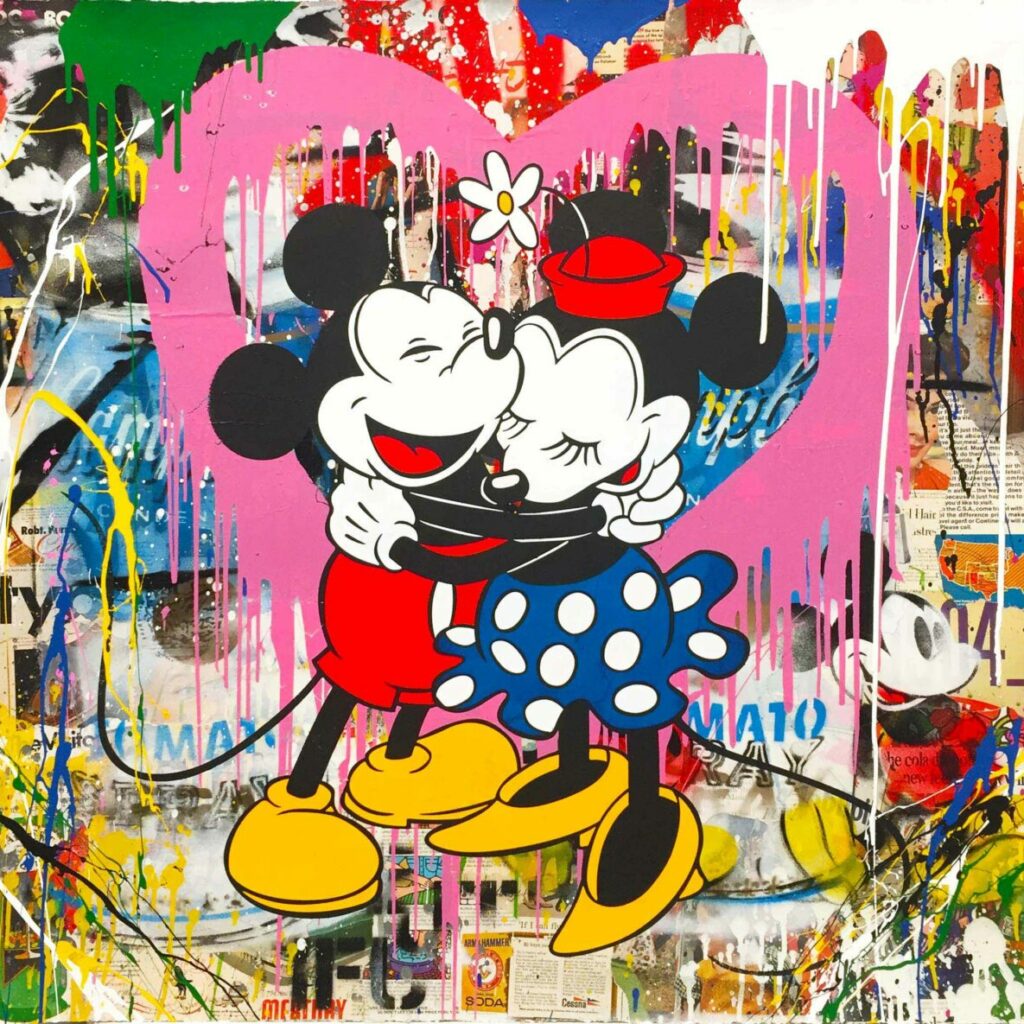
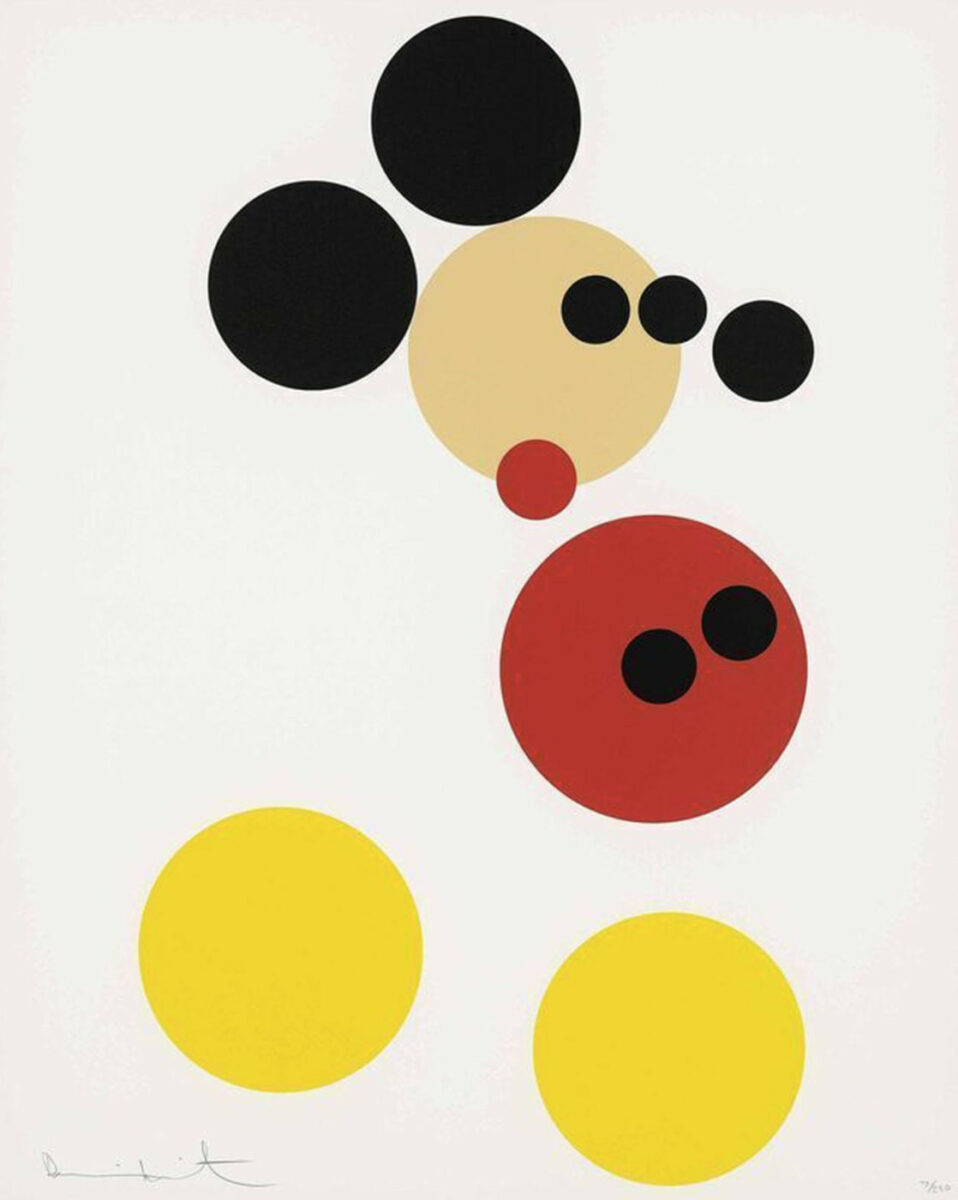
However, closer to Warhol’s time, Keith Haring’s 1986 Andy Mouse series is a full-circle moment, merging Warhol’s pop art legacy with Mickey’s enduring charm. Haring depicts a cartoonish Warhol donning Mickey Mouse ears, gloves and buttoned shorts, swimming in dollar bills, and dancing—capturing the essence of both icons. The series is a tribute to Warhol’s influence on Haring and a nod to Warhol’s admiration for Disney. It’s a synthesis of American pop culture, embodying themes Warhol explored but never fully realized with his own Mickey.
The Allure of Warhol's Double Mickey Mouse
As we’ve journeyed through the labyrinth of Mickey Mouse’s artistic legacy, from his early days as a cultural icon to his transformative role in modern and contemporary art, one thing becomes abundantly clear: Mickey Mouse is not just a cartoon character; he’s a phenomenon, a cultural touchstone that artists like Warhol have elevated into the realm of myth. And it’s precisely this mythic quality that makes Warhol’s Double Mickey Mouse a masterpiece of both art and cultural commentary.
The piece, with its dual imagery and sparkling backdrop, is not just a tribute to Mickey Mouse but a reflection of Warhol’s own complexities—his aspirations, his critiques, and his ceaseless fascination with the American Dream. It’s a work that invites us to ponder the transformative power of art and media, to question the boundaries between commercialism and creativity, and to celebrate the enduring impact of icons that shape our collective imagination.
So, as we unveil this extraordinary artwork at Revolver Gallery, we invite you to experience the magic of Double Mickey Mouse for yourself. It’s not just an artwork; it’s a conversation starter, a thought-provoker, and a testament to the enduring allure of Mickey Mouse—an allure that, much like the character himself, seems destined to remain timeless. See it, feel it, and engage with a piece that encapsulates the very essence of Warhol’s artistry and the indelible mark Mickey Mouse has left on the canvas of American culture.


